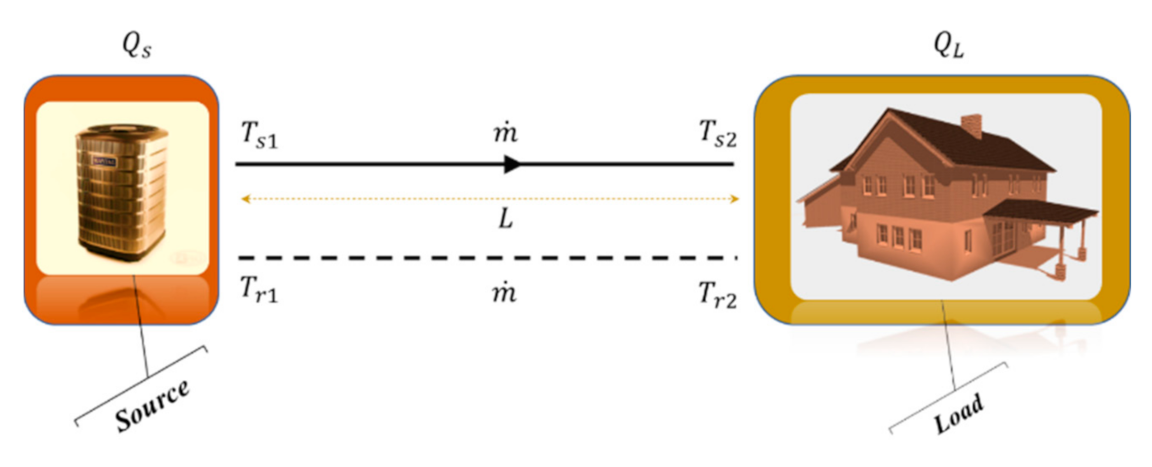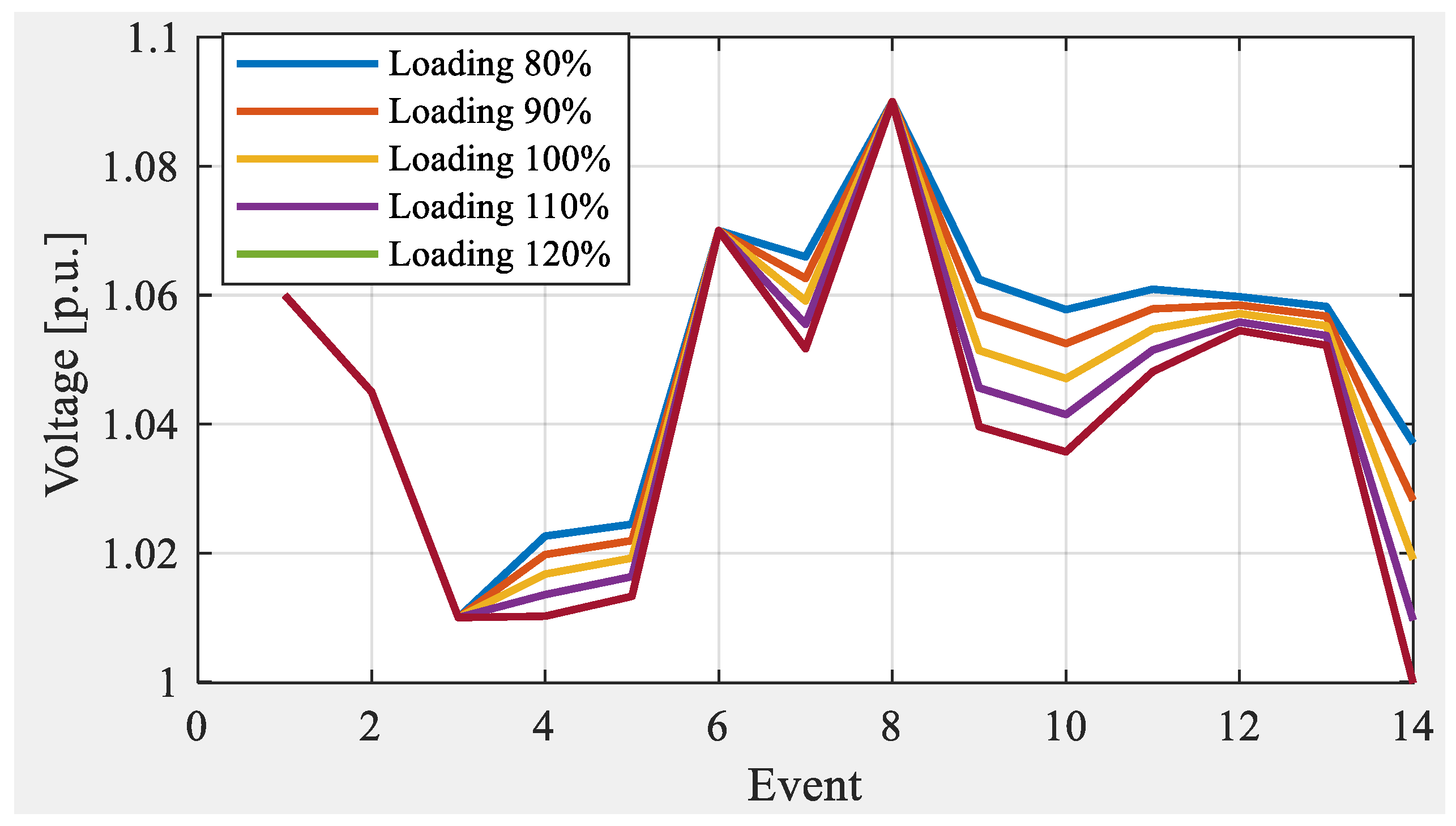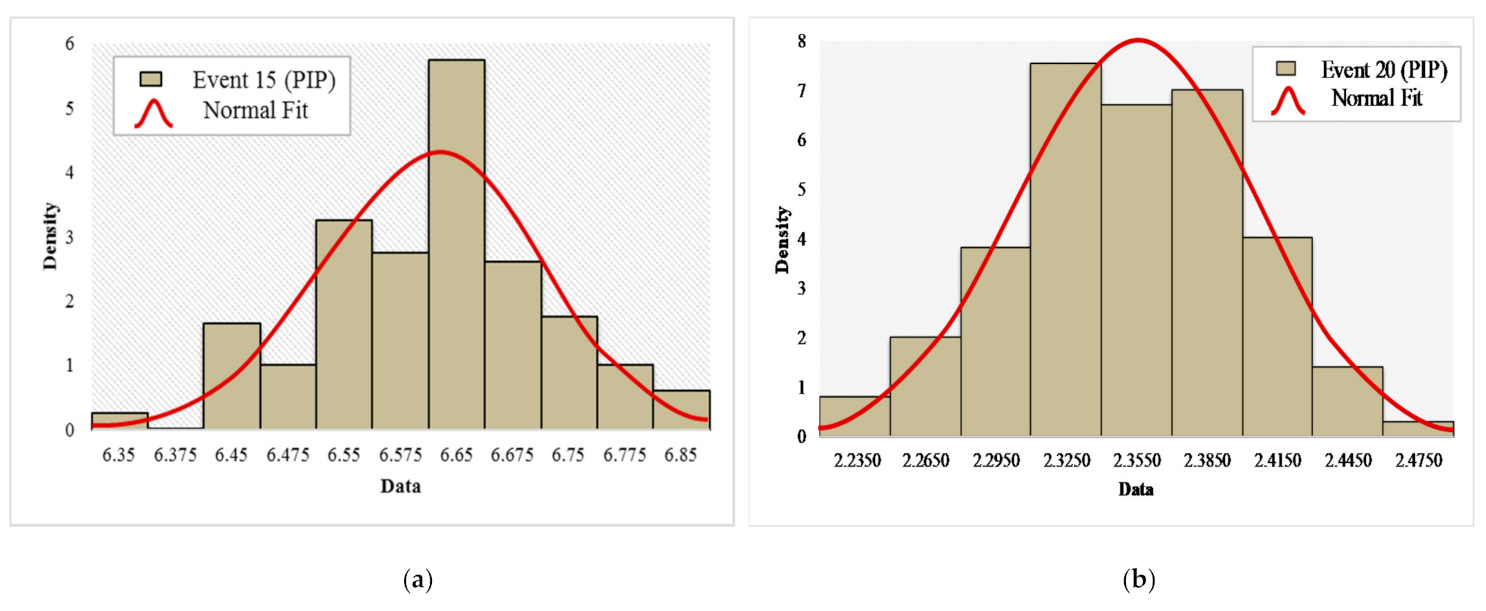Security Analysis of Hybrid Multi-Carrier Energy Systems
Abstract
:1. Introduction
- The security assessment of MCESs with various energy networks, including electrical, natural gas, and district heating networks, is analyzed.
- In the electrical network, the NR technique is adopted to investigate possible events, where the calculation of the performance indices is made by employing the PIP and PIV for each line or component.
- The security assessment of natural gas and district heating networks is accomplished by adopting the concept of Energy not supplied (ENS).
2. MCES Modeling
2.1. Electrical Network
2.2. Natural Gas Network
2.3. District Heating Network
2.4. Network Components
2.4.1. Gas Power Plants
2.4.2. Combined Heat and Power (CHP)
2.4.3. Gas Boiler
2.4.4. Compressor
2.4.5. Circulating Pump
3. Security Indices in MCESs
3.1. Performance Index of Power (PIP)
3.2. Performance Index of Voltage (PIV)
3.3. Energy Not Supplied (ENS)
4. Simulation Results
4.1. Test System
4.2. Results and Discussion
4.2.1. Test-System1: (IEEE 14-Bus)
4.2.2. Test-System 2: (IEEE 30-Bus)
5. Conclusions
Author Contributions
Funding
Institutional Review Board Statement
Informed Consent Statement
Data Availability Statement
Conflicts of Interest
Nomenclature
| A. MCES Coefficients/Variables | |
| , | Voltage amplitude of buses and |
| Admittance between buses and | |
| , | Active and reactive demand of the ithe bus |
| , | Voltage angle of buses and |
| Difference between angles of buses and bus | |
| Conductance and sustenance of transmission line between buses and | |
| Gas flow passing through the pipeline connected between nodes and | |
| , | Gas demand and constant of the pipeline connected between nodes i and j |
| Gas density against air | |
| Specific gravity of the gas | |
| Average coefficient of gas compressibility | |
| , | Specific heat ratio and gas temperature |
| , | Length and diameter of the gas pipeline between nodes and |
| Gas pressures related to nodes and | |
| , | Standard values of pressure and temperature |
| Mass flow rate of through pipelines | |
| , | Supply and return temperature at node |
| Water specific heat capacity | |
| Transmission pipe constant | |
| Ambient temperature | |
| Heat transfer coefficient of the pipe length | |
| , | Length and mass flow rate between nodes and |
| , , | Cost coefficient of the ith generator |
| Generated power by ith generator | |
| Heat rate of the ith generator | |
| Gross heating value | |
| Electrical and heat power of ith CHP | |
| Minimum/maximum amount of heat output | |
| Supply temperature of ith CHP | |
| Load effect variables | |
| Thermal efficiency of the ith CHP | |
| Heat power of the ith boiler | |
| Part load constants of the ith boiler | |
| Inlet and outlet pressures of ith compressor | |
| Compressor efficiency | |
| Mass flow rate through the pump | |
| Pump head | |
| Ground gravity | |
| Efficiency of the ith circulating pump | |
| B. Security Assessment Coefficients/Variables | |
| Power passing through the line | |
| Maximum apparent power passing through line | |
| Number of lines in the power system | |
| Positive weight coefficient of network lines | |
| Constant parameter | |
| Weight factor for the bus | |
| , | Minimum/maximum acceptable voltages on the bus |
| , | Amount of gas and thermal ENS in the event |
| Abbreviations | |
| MCES | Multi-carrier energy system |
| OPF | Optimal power flow |
| CHP | Combined heat and power |
| ENS | Energy not supplied |
| HR | Heat rate |
| GHV | Gross heating value |
| MC | Monte Carlo |
| PIP | Power performance index |
| PIV | Voltage performance index |
References
- Arabkoohsar, A.; Nami, H. Thermodynamic and economic analyses of a hybrid waste-driven CHP–ORC plant with exhaust heat recovery. Energy Convers. Manag. 2019, 187, 512–522. [Google Scholar] [CrossRef]
- Diesendorf, M.; Elliston, B. The feasibility of 100% renewable electricity systems: A response to critics. Renew. Sustain. Energy Rev. 2018, 93, 318–330. [Google Scholar] [CrossRef]
- Arabkoohsar, A.; Andresen, G. Supporting district heating and cooling networks with a bifunctional solar assisted absorption chiller. Energy Convers. Manag. 2017, 148, 184–196. [Google Scholar] [CrossRef]
- Nazari-Heris, M.; Mohammadi-Ivatloo, B.; Asadi, S. Optimal Operation of Multi-Carrier Energy Networks Considering Uncertain Parameters and Thermal Energy Storage. Sustainability 2020, 12, 5158. [Google Scholar] [CrossRef]
- Martinez-Mares, A.; Fuerte-Esquivel, C.R. A Unified Gas and Power Flow Analysis in Natural Gas and Electricity Coupled Networks. IEEE Trans. Power Syst. 2012, 27, 2156–2166. [Google Scholar] [CrossRef]
- Geidl, M.; Andersson, G. Operational and structural optimization of multi-carrier energy systems. Eur. Trans. Electr. Power 2006, 16, 463–477. [Google Scholar] [CrossRef]
- Nazari-Heris, M.; Mohammadi-Ivatloo, B.; Asadi, S. Optimal operation of multi-carrier energy networks with gas, power, heating, and water energy sources considering different energy storage technologies. J. Energy Storage 2020, 31, 101574. [Google Scholar] [CrossRef]
- Geidl, M.; Andersson, G. Operational and topological optimization of multi-carrier energy systems. In Proceedings of the International Conference on Future Power Systems, Amsterdam, The Netherlands, 16–18 November 2005; p. 6. [Google Scholar]
- Geidl, M.; Andersson, G. Optimal Power Flow of Multiple Energy Carriers. IEEE Trans. Power Syst. 2007, 22, 145–155. [Google Scholar] [CrossRef]
- Waller-Hunter, J. Caring for Climate: A Guide to the Climate Change Convention and the Kyoto Protocol; UNFCCC: Bonn, France, 2005. [Google Scholar]
- Heris, M.-N.; Mirzaei, M.A.; Asadi, S.; Mohammadi-Ivatloo, B.; Zare, K.; Jebelli, H.; Marzband, M. Evaluation of hydrogen storage technology in risk-constrained stochastic scheduling of multi-carrier energy systems considering power, gas and heating network constraints. Int. J. Hydrogen Energy 2020, 45, 30129–30141. [Google Scholar] [CrossRef]
- Niemi, R.; Mikkola, J.; Lund, P. Urban energy systems with smart multi-carrier energy networks and renewable energy generation. Renew. Energy 2012, 48, 524–536. [Google Scholar] [CrossRef]
- Geidl, M. Integrated Modeling and Optimization of Multi-Carrier Energy Systems. Ph.D. Thesis, Technical University ETH Zurich, Zurich, Switzerland, 2007. [Google Scholar]
- Arnold, M.; Andersson, G. Decomposed Electricity and Natural Gas Optimal Power Flow. Available online: https://citeseerx.ist.psu.edu/viewdoc/download?doi=10.1.1.164.5769&rep=rep1&type=pdf (accessed on 1 January 2021).
- Moeini-Aghtaie, M.; Abbaspour, A.; Fotuhi-Firuzabad, M.; Hajipour, E. A Decomposed Solution to Multiple-Energy Carriers Optimal Power Flow. IEEE Trans. Power Syst. 2013, 29, 707–716. [Google Scholar] [CrossRef]
- Li, Q.; An, S.; Gedra, T.W. Solving Natural Gas Loadflow Problems Using Electric Loadflow Techniques. pp. 1–7. Available online: https://citeseerx.ist.psu.edu/viewdoc/download?doi=10.1.1.80.9709&rep=rep1&type=pdf (accessed on 28 February 2021).
- Li, X.; Tian, G.; Shi, Q.; Jiang, T.; Li, F.; Jia, H. Security region of natural gas network in electricity-gas integrated energy system. Int. J. Electr. Power Energy Syst. 2020, 117, 105601. [Google Scholar] [CrossRef]
- Shabanpour-Haghighi, A.; Seifi, A.R. An Integrated Steady-State Operation Assessment of Electrical, Natural Gas, and District Heating Networks. IEEE Trans. Power Syst. 2015, 31, 3636–3647. [Google Scholar] [CrossRef]
- Gargari, M.Z.; Ghaffarpour, R. Reliability evaluation of multi-carrier energy system with different level of demands under various weather situation. Energy 2020, 196, 117091. [Google Scholar] [CrossRef]
- Bai, L.; Li, F.; Jiang, T.; Jia, H. Robust Scheduling for Wind Integrated Energy Systems Considering Gas Pipeline and Power Transmission N-1 Contingencies. IEEE Trans. Power Syst. 2016, 32, 1. [Google Scholar] [CrossRef]
- Chen, S.; Wei, Z.; Sun, G.; Sun, Y.; Lu, N. Steady-state security regions of electricity-gas integrated energy systems. In Proceedings of the IEEE Power and Energy Society General Meeting (PESGM), Boston, MA, USA, 17–21 July 2016; pp. 1–5. [Google Scholar]
- Li, G.; Kou, Y.; Jiang, J.; Lin, Y.; Bie, Z. Researches on the reliability evaluation of integrated energy system based on Energy Hub. In Proceedings of the China International Conference on Electricity Distribution (CICED), Xi’an, China, 10–13 August 2016; pp. 1–9. [Google Scholar]
- Yang, H.; Zhang, Y.; Ma, Y.; Zhang, D.; Sun, L.; Xia, S. Reliability assessment of integrated energy system considering the uncertainty of natural gas pipeline network system. IET Gener. Transm. Distrib. 2019, 13, 5033–5041. [Google Scholar] [CrossRef]
- Li, G.; Zhang, R.; Jiang, T.; Chen, H.; Bai, L.; Li, X. Security-constrained bi-level economic dispatch model for integrated natural gas and electricity systems considering wind power and power-to-gas process. Appl. Energy 2017, 194, 696–704. [Google Scholar] [CrossRef]
- Azzuni, A.; Breyer, C. Energy security and energy storage technologies. Energy Procedia 2018, 155, 237–258. [Google Scholar] [CrossRef]
- Li, T.; Eremia, M.; Shahidehpour, M. Interdependency of Natural Gas Network and Power System Security. IEEE Trans. Power Syst. 2008, 23, 1817–1824. [Google Scholar] [CrossRef]
- Yan, M.; Zhang, N.; Ai, X.; Shahidehpour, M.; Kang, C.; Wen, J. Robust two-stage regional-district scheduling of multi-carrier energy systems with a large penetration of wind power. IEEE Trans. Sustain. Energy 2018, 10, 1227–1239. [Google Scholar] [CrossRef]
- Shariatkhah, M.-H.; Haghifam, M.-R.; Parsa-Moghaddam, M.; Siano, P. Modeling the reliability of multi-carrier energy systems considering dynamic behavior of thermal loads. Energy Build. 2015, 103, 375–383. [Google Scholar] [CrossRef]
- Fathtabar, H.; Barforoushi, T.; Shahabi, M. Dynamic long-term expansion planning of generation resources and electric transmission network in multi-carrier energy systems. Int. J. Electr. Power Energy Syst. 2018, 102, 97–109. [Google Scholar] [CrossRef]
- Naik, S.; Khedkar, M.; Bhat, S. Effect of line contingency on static voltage stability and maximum loadability in large multi bus power system. Int. J. Electr. Power Energy Syst. 2015, 67, 448–452. [Google Scholar] [CrossRef]
- Pazouki, S.; Mohsenzadeh, A.; Ardalan, S.; Haghifam, M. Optimal place, size, and operation of combined heat and power in multi carrier energy networks considering network reliability, power loss, and voltage profile. IET Gener. Transm. Distrib. 2016, 10, 1615–1621. [Google Scholar] [CrossRef]
- Lei, Y.; Hou, K.; Wang, Y.; Jia, H.; Zhang, P.; Mu, Y.; Jin, X.; Sui, B. A new reliability assessment approach for integrated energy systems: Using hierarchical decoupling optimization framework and impact-increment based state enumeration method. Appl. Energy 2018, 210, 1237–1250. [Google Scholar] [CrossRef]
- Liu, X.; Jenkins, N.; Wu, J.; Bagdanavicius, A. Combined Analysis of Electricity and Heat Networks. Energy Procedia 2014, 61, 155–159. [Google Scholar] [CrossRef] [Green Version]
- Shabanpour-Haghighi, A.; Seifi, A.R. Simultaneous integrated optimal energy flow of electricity, gas, and heat. Energy Convers. Manag. 2015, 101, 579–591. [Google Scholar] [CrossRef]
- Liu, X.; Wu, J.; Jenkins, N.; Bagdanavicius, A. Combined analysis of electricity and heat networks. Appl. Energy 2016, 162, 1238–1250. [Google Scholar] [CrossRef] [Green Version]
- Shabanpour-Haghighi, A.; Seifi, A.R. Energy Flow Optimization in Multicarrier Systems. IEEE Trans. Ind. Inform. 2015, 11, 1067–1077. [Google Scholar] [CrossRef]
- Sachan, S.; Gupta, C. Analysis of contingent conditions in power system. In Proceedings of the 2014 Students Conference on Engineering and Systems, Allahabad, India, 28–30 May 2014; pp. 1–5. [Google Scholar]
- Sekhar, P.; Mohanty, S. Power system contingency ranking using Newton Raphson load flow method. In Proceedings of the Annual IEEE India Conference (INDICON), Mumbay, India, 13–15 December 2013; pp. 1–4. [Google Scholar]
- Gongada, S.R.; Rao, T.S.; Rao, P.M.; Salima, S. Power system contingency ranking using fast decoupled load flow method. In Proceedings of the International Conference on Electrical, Electronics and Optimization Techniques (ICEEOT), Chennai, India, 3–5 March 2016; pp. 4373–4376. [Google Scholar]
- Hashemi-Dezaki, H.; Askarian-Abyaneh, H.; Haeri-Khiavi, H. Reliability optimization of electrical distribution systems using internal loops to minimize energy not-supplied (ENS). J. Appl. Res. Technol. 2015, 13, 416–424. [Google Scholar] [CrossRef] [Green Version]
- Heggset, J.; Kjolle, G.H.; Trengereid, F.; Ween, H.O. Quality of supply in the deregulated Norwegian power system. In Proceedings of the IEEE Porto Power Techology Proceedings (Cat. No.01EX502), Porto, Portugal, 10–13 September 2001. [Google Scholar]
- Unsihuay, C.; Lima, J.W.M.; De Souza, A.Z. Modeling the Integrated Natural Gas and Electricity Optimal Power Flow. In Proceedings of the IEEE Power Engineering Society General Meeting, Tampa, FL, USA, 24–28 June 2007; pp. 1–7. [Google Scholar]
- Soeprijanto, A.; Abdillah, M. Type 2 fuzzy adaptive binary particle swarm optimization for optimal placement and sizing of distributed generation. In Proceedings of the 2nd International Conference on Instrumentation Communications, Information Technology, and Biomedical Engineering, Bandung, Indonesia, 8–9 November 2011; pp. 233–238. [Google Scholar]
- Iyambo, P.; Tzoneva, R. Transient stability analysis of the IEEE 14-bus electric power system. In Proceedings of the 2nd International Conference on Instrumentation, Communications, Information Technology and Biomedical Engineering, Bandung, Indonesia, 8–9 November 2011; pp. 1–9. [Google Scholar]
- De Wolf, D.; Smeers, Y. The Gas Transmission Problem Solved by an Extension of the Simplex Algorithm. Manag. Sci. 2000, 46, 1454–1465. [Google Scholar] [CrossRef] [Green Version]



















| Type of Energy Carriers | Technique Formulation | Energy Not-Supplied Analysis | Sensitivity Analyisis of the PIV/PIV | |
|---|---|---|---|---|
| Proposed Model | IEEE 14-bus system, IEEE 30-bus, 20-node Belgian gas network, and 14-node district 18 heating network | Newton-Raphson (N-R) | ||
| Ref. [5] | IEEE 14-bus electrical network, a 15-node gas network and Belgian gas network | Newton-Raphson (N-R) | ||
| Ref. [29] | Six bus power network and 24-bus IEEE electrical network | Mixed integer linear programming (MILP) | ||
| Ref. [30] | 26 bus power system | Newton-Raphson (N-R) | ||
| Ref. [31] | Electrical and gas networks with 32 demand points | Genetic algorithm (GA) | ||
| Ref. [32] | IEEE-33 bus system with 14-node gas system combined with the IEEE 118-bus power system and Belgian gas network | Hierarchical decoupling optimization |
| Electrical Network | Natural Gas Network | District Heating Network |
|---|---|---|
| Unit | Electric Bus | Gas Node | Thermal Node |
|---|---|---|---|
| Slack generator | 1 | 12 | --- |
| Generator 2 | 2 | 19 | --- |
| Compressor motor 1 | 4 | 9 | --- |
| CHP, boiler, and pump | 6 | 15 | 4 |
| CHP, boiler, and pump | 13 | 7 | 9 |
| CHP, boiler, and pump | 14 | 6 | 10 |
| CHP, boiler, and pump | 8 | 10 | 13 |
Publisher’s Note: MDPI stays neutral with regard to jurisdictional claims in published maps and institutional affiliations. |
© 2021 by the authors. Licensee MDPI, Basel, Switzerland. This article is an open access article distributed under the terms and conditions of the Creative Commons Attribution (CC BY) license (http://creativecommons.org/licenses/by/4.0/).
Share and Cite
Estakhr, J.; Simab, M.; Niknam, T. Security Analysis of Hybrid Multi-Carrier Energy Systems. Sustainability 2021, 13, 3102. https://doi.org/10.3390/su13063102
Estakhr J, Simab M, Niknam T. Security Analysis of Hybrid Multi-Carrier Energy Systems. Sustainability. 2021; 13(6):3102. https://doi.org/10.3390/su13063102
Chicago/Turabian StyleEstakhr, Javad, Mohsen Simab, and Taher Niknam. 2021. "Security Analysis of Hybrid Multi-Carrier Energy Systems" Sustainability 13, no. 6: 3102. https://doi.org/10.3390/su13063102
APA StyleEstakhr, J., Simab, M., & Niknam, T. (2021). Security Analysis of Hybrid Multi-Carrier Energy Systems. Sustainability, 13(6), 3102. https://doi.org/10.3390/su13063102




